Properties
| Storage Buffer | PBS pH7.4, 50% glycerol, 0.09% sodium azide *Storage buffer may change when conjugated |
| Storage Temperature | -20ºC, Conjugated antibodies should be stored according to the product label |
| Shipping Temperature | Blue Ice or 4ºC |
| Purification | Protein G Purified |
| Clonality | Recombinant Monoclonal |
| Clone Number | S57 |
| Isotype | IgG1 |
| Specificity | Detects ~240kDa (varies with cell background due to glycosylation). |
| Cite This Product | Cav1.2 Antibody (StressMarq Biosciences | Victoria, BC CANADA, Catalog# SMC-300, RRID: AB_2069099) |
| Certificate of Analysis | 1 µg/ml of SMC-300 was sufficient for detection of Cav1.2 in 10 µg of rat brain lysate by colorimetric immunoblot analysis using Goat anti-mouse IgG:HRP as the secondary antibody. |
Biological Description
| Alternative Names | Voltage-dependent L-type calcium channel subunit alpha-1C, Cav1.2, Calcium channel, L type, alpha-1 polypeptide, isoform 1, cardiac muscle, Voltage-gated calcium channel subunit alpha Cav1.2, DHPR alpha-1 subunit, CACH3, CACN4, CACNL1A2, alpha-1 subunit voltage-dependent calcium channel, calcium channel voltage-dependent L type alpha 1C subunit1, calcium channel L type, alpha 1 polypeptide isoform 1 cardiac muscle, calcium channel cardiac dihydropyridine-sensitive alpha-1 subunit, voltage-gated L-type calcium channel Cav1.2 alpha 1 subunit splice variant 10 |
| Research Areas | Calcium Channels, Cancer, Cardiovascular System, Cell Signaling, Heart, Ion Channels, Neuroscience, Voltage-Gated Calcium Channels |
| Cellular Localization | Cell membrane, Membrane |
| Accession Number | NP_001129994.1 |
| Gene ID | 100101555 |
| Swiss Prot | P15381 |
| Scientific Background |
Cav1.2, encoded by the CACNA1C gene, is a major subunit of the L-type voltage-gated calcium channel family, best known for its role in cardiac excitation-contraction coupling. However, beyond the heart, Cav1.2 is highly expressed in the brain, where it regulates calcium influx critical for neuronal excitability, synaptic plasticity, and gene transcription. Dysregulation of Cav1.2 has been implicated in a range of neurological and neuropsychiatric disorders. Mutations in CACNA1C are causally linked to Timothy syndrome, a rare multisystem disorder characterized by cardiac arrhythmias, autism spectrum features, and cognitive impairment. Additionally, variants in CACNA1C have been associated with Brugada syndrome and are increasingly recognized as genetic risk factors for bipolar disorder, schizophrenia, and major depressive disorder. In the context of neurodegenerative disease, altered Cav1.2 function may contribute to disrupted calcium homeostasis, oxidative stress, and neuronal vulnerability—hallmarks of conditions such as Alzheimer’s and Parkinson’s disease. Its role in activity-dependent gene expression also positions Cav1.2 as a key modulator of long-term neuronal survival and plasticity. Given its dual importance in cardiac and neural physiology, Cav1.2 is a promising target for therapeutic strategies aimed at restoring calcium signaling balance in both neurodevelopmental and neurodegenerative disorders. |
| References |
1. Splawski I., et al. (2004) Cell. 119 (1): 19-31. 2. Krey J.F., and Dolmetsch R. (2009) Biophysical. 96 (3): 221a-222a. 3. Crotti L., Celano G., Dagradi F. and Schwartz P.J. (2008) Orphanet J Rare Disease 3:18. |
Product Images
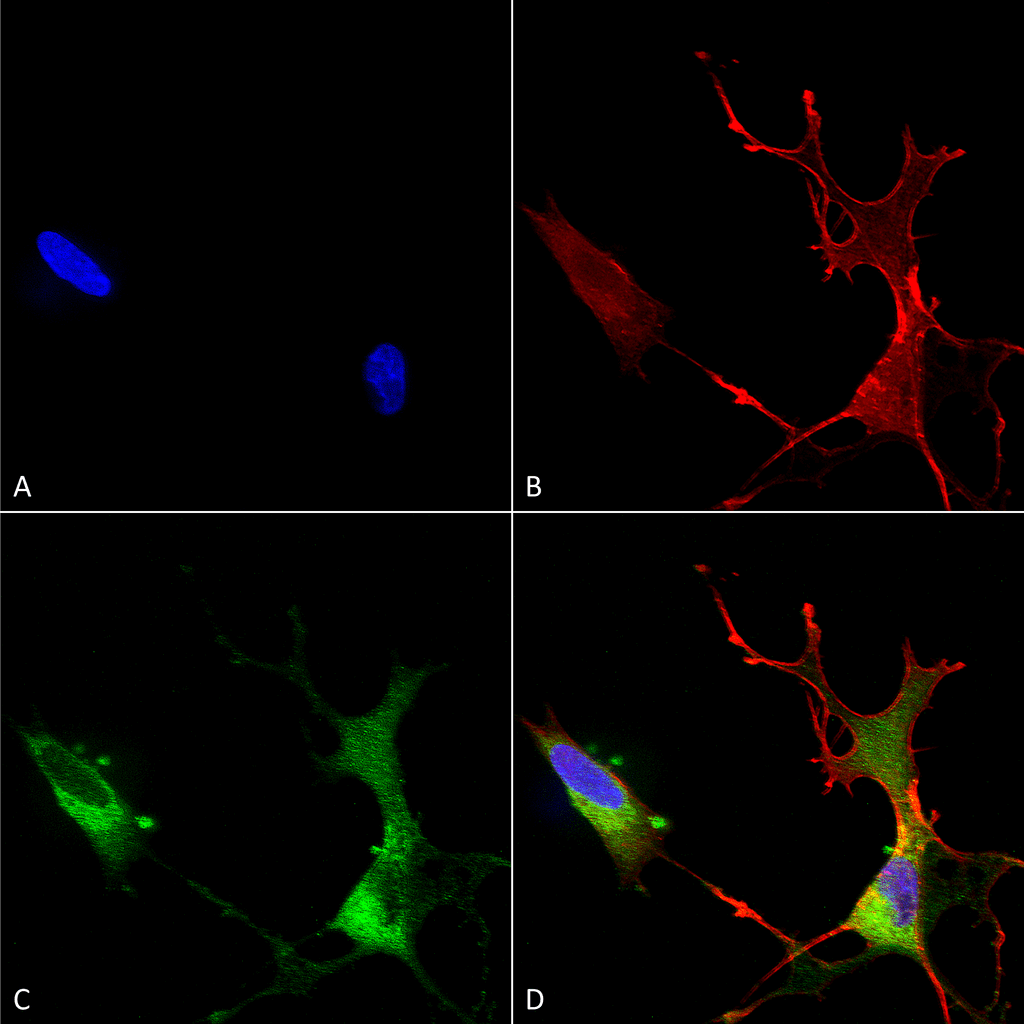
Immunocytochemistry/Immunofluorescence analysis using Mouse Anti-Cav1.2 Monoclonal Antibody, Clone S57 (SMC-300). Tissue: Neuroblastoma cells (SH-SY5Y). Species: Human. Fixation: 4% PFA for 15 min. Primary Antibody: Mouse Anti-Cav1.2 Monoclonal Antibody (SMC-300) at 1:50 for overnight at 4°C with slow rocking. Secondary Antibody: AlexaFluor 488 at 1:1000 for 1 hour at RT. Counterstain: Phalloidin-iFluor 647 (red) F-Actin stain; Hoechst (blue) nuclear stain at 1:800, 1.6mM for 20 min at RT. (A) Hoechst (blue) nuclear stain. (B) Phalloidin-iFluor 647 (red) F-Actin stain. (C) Cav1.2 Antibody (D) Composite.
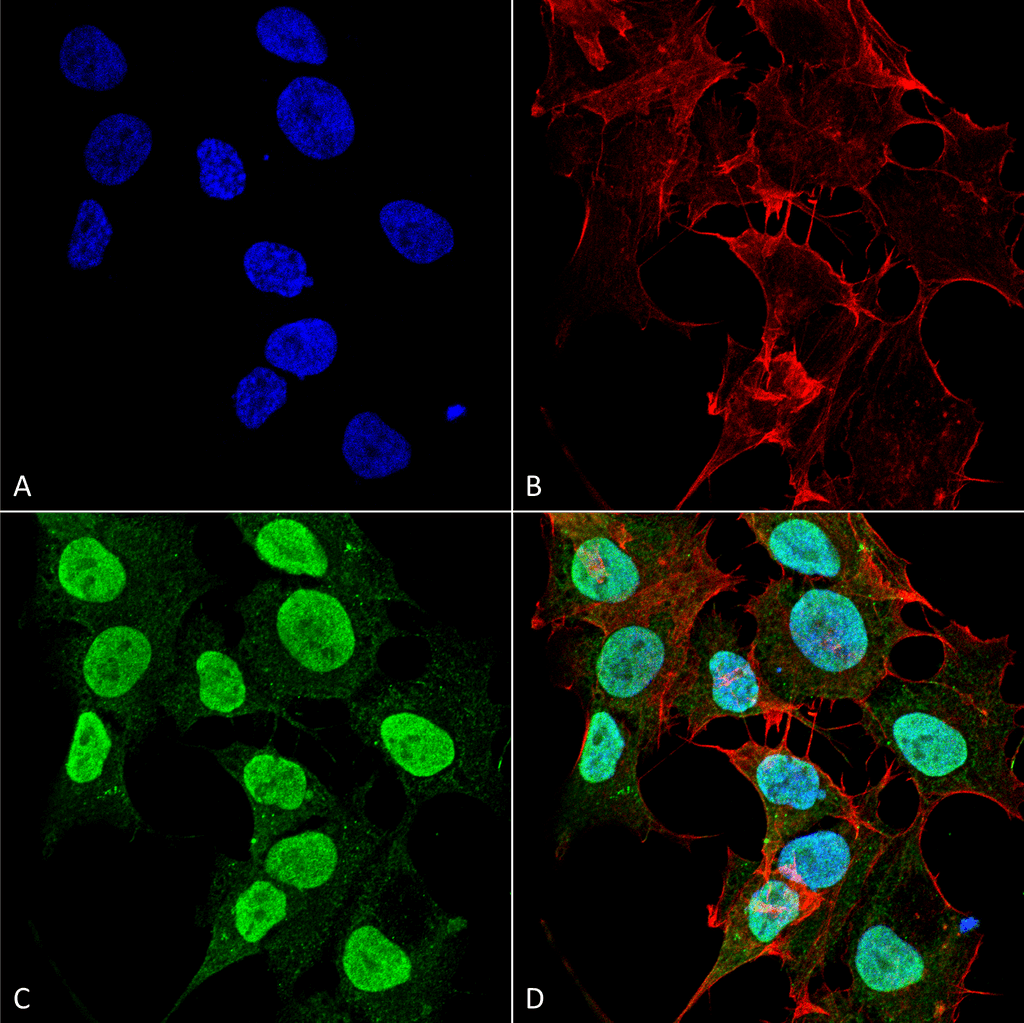
Immunocytochemistry/Immunofluorescence analysis using Mouse Anti-Cav1.2 Monoclonal Antibody, Clone S57 (SMC-300). Tissue: Neuroblastoma cell line (SK-N-BE). Species: Human. Fixation: 4% Formaldehyde for 15 min at RT. Primary Antibody: Mouse Anti-Cav1.2 Monoclonal Antibody (SMC-300) at 1:100 for 60 min at RT. Secondary Antibody: Goat Anti-Mouse ATTO 488 at 1:200 for 60 min at RT. Counterstain: Phalloidin Texas Red F-Actin stain; DAPI (blue) nuclear stain at 1:1000, 1:5000 for 60 min at RT, 5 min at RT. Localization: Cell Membrane, Membrane, Cytoplasm, Nucleoplasm. Magnification: 60X. (A) Phalloidin Texas Red F-Actin stain; DAPI (blue) nuclear stain. (B) Anti-Cav1.2 Antibody. (C) Composite. (A) DAPI (blue) nuclear stain. (B) Phalloidin Texas Red F-Actin stain. (C) Cav1.2 Antibody. (D) Composite.
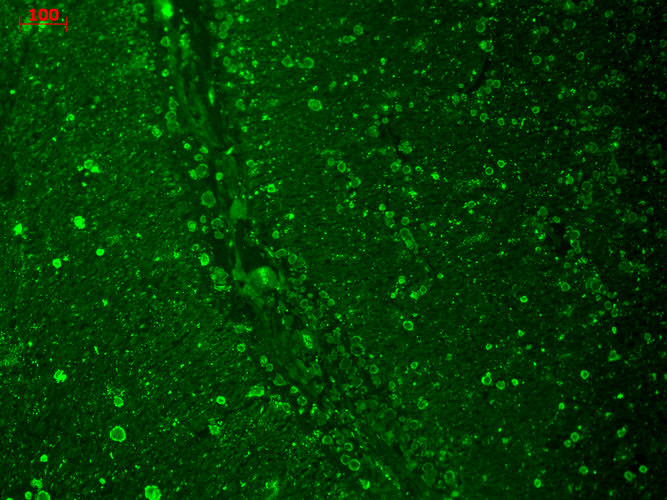
Immunohistochemistry analysis using Mouse Anti-CaV1.2 Calcium Channel Monoclonal Antibody, Clone S57 (SMC-300). Tissue: hippocampus. Species: Human. Fixation: 10% formalin. Primary Antibody: Mouse Anti-CaV1.2 Calcium Channel Monoclonal Antibody (SMC-300) at 1:100 for 1 hour at RT. Secondary Antibody: FITC Goat Anti-Mouse (green) at 1:50 for 1 hour at RT.
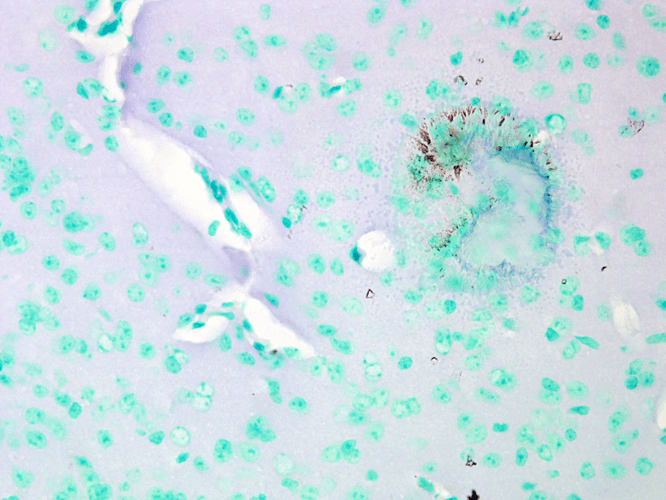
Immunohistochemistry analysis using Mouse Anti-CaV1.2 Calcium channel Monoclonal Antibody, Clone S57 (SMC-300). Tissue: Brain Tissue. Species: Mouse. Fixation: Formalin. Primary Antibody: Mouse Anti-CaV1.2 Calcium channel Monoclonal Antibody (SMC-300) at 1:10000 for 12 hours at 4°C. Secondary Antibody: Biotin Goat Anti-Mouse at 1:2000 for 1 hour at RT. Counterstain: Mayer Hematoxylin (purple/blue) nuclear stain at 200 µl for 2 minutes at RT. Magnification: 40x.
![<p>Western Blot analysis with StressMarq’s Anti-Cav1.2 Antibody [S57] (SMC-300) showing detection of Cav1.2 in HEK293 whole cell lysate (Rockland W09-000-365) heated at 60°C for 10 minutes. Human Cav1.2 protein (UniProt Q13936) has a predicted molecular weight of ~249 kDa. Block: 2% skim milk + 2% BSA. Primary Antibody: Mouse Anti-Rabbit Cav1.2 Monoclonal IgG1 (SMC-300) at 1:1000 for 2 hours at RT. Secondary Antibody: Goat Anti-Mouse IgG:HRP at 1:5000 for 1 hour at RT. Color Development: Chemiluminescent for HRP (Moss) for 3 min at RT. Exposed 30 seconds.</p>](https://www.stressmarq.com/wp-content/uploads/SMC-300_Cav1.2_Antibody_S57_WB_Human_HEK293_1.png)
Western Blot analysis with StressMarq’s Anti-Cav1.2 Antibody [S57] (SMC-300) showing detection of Cav1.2 in HEK293 whole cell lysate (Rockland W09-000-365) heated at 60°C for 10 minutes. Human Cav1.2 protein (UniProt Q13936) has a predicted molecular weight of ~249 kDa. Block: 2% skim milk + 2% BSA. Primary Antibody: Mouse Anti-Rabbit Cav1.2 Monoclonal IgG1 (SMC-300) at 1:1000 for 2 hours at RT. Secondary Antibody: Goat Anti-Mouse IgG:HRP at 1:5000 for 1 hour at RT. Color Development: Chemiluminescent for HRP (Moss) for 3 min at RT. Exposed 30 seconds.
![<p>Western Blot analysis with StressMarq’s Anti-Cav1.2 Antibody [S57] (SMC-300) showing detection of Cav1.2 in mouse brain lysate (Novus NB820-59657) heated at 60°C for 10 minutes. Mouse Cav1.2 protein (UniProt Q01815) has a predicted molecular weight of ~240 kDa. Block: 2% skim milk + 2% BSA. Primary Antibody: Mouse Anti-Rabbit Cav1.2 Monoclonal IgG1 (SMC-300) at 1:1000 for 2 hours at RT. Secondary Antibody: Goat Anti-Mouse IgG:HRP at 1:5000 for 1 hour at RT. Color Development: Chemiluminescent for HRP (Moss) for 3 min at RT. Exposed 3 seconds.</p>](https://www.stressmarq.com/wp-content/uploads/SMC-300_Cav1.2_Antibody_S57_WB_Mouse_brain-lysate_1.png)
Western Blot analysis with StressMarq’s Anti-Cav1.2 Antibody [S57] (SMC-300) showing detection of Cav1.2 in mouse brain lysate (Novus NB820-59657) heated at 60°C for 10 minutes. Mouse Cav1.2 protein (UniProt Q01815) has a predicted molecular weight of ~240 kDa. Block: 2% skim milk + 2% BSA. Primary Antibody: Mouse Anti-Rabbit Cav1.2 Monoclonal IgG1 (SMC-300) at 1:1000 for 2 hours at RT. Secondary Antibody: Goat Anti-Mouse IgG:HRP at 1:5000 for 1 hour at RT. Color Development: Chemiluminescent for HRP (Moss) for 3 min at RT. Exposed 3 seconds.
![<p>Western Blot analysis with StressMarq’s Anti-Cav1.2 Antibody [S57] (SMC-300) showing detection of Cav1.2 in rat brain membrane lysate (prepared in-house) heated at 37°C for 10 minutes. Rat Cav1.2 protein (UniProt P22002) has a predicted molecular weight of ~243 kDa. Block: 2% skim milk + 2% BSA. Primary Antibody: Mouse Anti-Rabbit Cav1.2 Monoclonal IgG1 (SMC-300) at 1:1000 for 2 hours at RT. Secondary Antibody: Goat Anti-Mouse IgG:HRP at 1:5000 for 1 hour at RT. Color Development: Chemiluminescent for HRP (Moss) for 3 min at RT. Exposed 10 seconds.</p>](https://www.stressmarq.com/wp-content/uploads/SMC-300_Cav1.2_Antibody_S57_WB_Rat_brain-membrane-lysate_1.png)
Western Blot analysis with StressMarq’s Anti-Cav1.2 Antibody [S57] (SMC-300) showing detection of Cav1.2 in rat brain membrane lysate (prepared in-house) heated at 37°C for 10 minutes. Rat Cav1.2 protein (UniProt P22002) has a predicted molecular weight of ~243 kDa. Block: 2% skim milk + 2% BSA. Primary Antibody: Mouse Anti-Rabbit Cav1.2 Monoclonal IgG1 (SMC-300) at 1:1000 for 2 hours at RT. Secondary Antibody: Goat Anti-Mouse IgG:HRP at 1:5000 for 1 hour at RT. Color Development: Chemiluminescent for HRP (Moss) for 3 min at RT. Exposed 10 seconds.

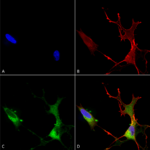
![Mouse Anti-Cav1.2 Antibody [S57] used in Immunoprecipitation (IP) on Rat INS-1E cells (SMC-300)](https://www.stressmarq.com/wp-content/uploads/SMC-300_Cav1.2_Antibody_S57_IP_Rat_INS-1E-cells_1-2.png)
![Mouse Anti-Cav1.2 Antibody [S57] used in Western Blot (WB) on Hamster T-CHO cell lysate (SMC-300)](https://www.stressmarq.com/wp-content/uploads/SMC-300_Cav1.2_Antibody_S57_WB_Hamster_T-CHO-cell-lysate_1-2.png)




















StressMarq Biosciences :
Based on validation through cited publications.